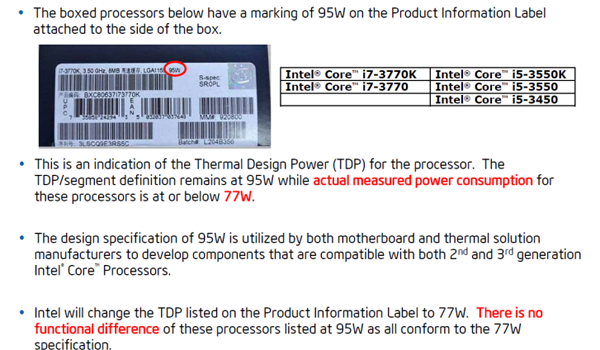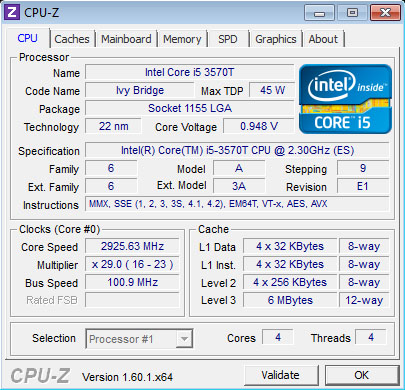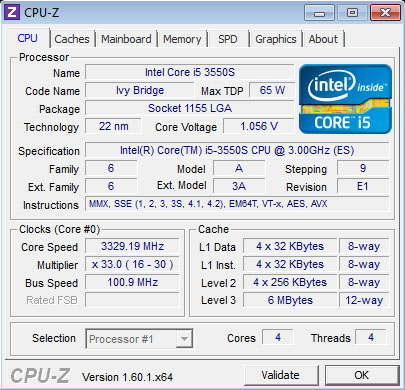Core i5-3570K, -3550, -3550S, And -3570T: Ivy Bridge Efficiency
After recommending Sandy Bridge last year, we weren't particularly impressed by the new Ivy Bridge-based Core i7-3770K as an upgrade. But are Intel's more mainstream third-gen Core i5 processors any more attractive? We grab four models to find out.
Lining Up The Contenders: Are There 95 W IVBs?
The first issue to address popped up while I was working on my launch piece last month. Before Ivy Bridge-based processors were even showing up on shelves, we were already getting reports that Intel’s retail boxes were printed with 95 W TDPs, and not the 77 W limits the company tried claiming.
Intel responded with the following:
“Third-generation Intel quad-core standard power processors have a TDP of 77 W. In some cases, you may continue to see references to a 95 W TDP. Intel has requested that original equipment manufacturers continue to design platforms based on Intel 7-series Express chipsets to a 95 W TDP target to ensure compatibility with second-generation Intel processors.”
So, platforms continue to be designed to support 95 W Sandy Bridge-based parts, but Ivy Bridge is 77 W, right?
Technically, yes. However, Intel did seem to goof up. It should have been using a 77 W spec on its boxed processors. We received the following shortly after publishing our Core i7-3770K story:
The company seemingly used 95 W to indicate platform support, when it should have been citing the specification for the Ivy Bridge-based parts themselves. So, expect to see those five models (the -3550K should probably be -3570K) listed as 77 W parts moving forward.
Core i5-3570T: 45 W
Get Tom's Hardware's best news and in-depth reviews, straight to your inbox.
From the bottom, Core i5-3570T is our lone 45 W sample. Intel achieves its aggressively low thermal ceiling by dropping the chip’s base clock to 2.3 GHz and only allowing Turbo Boost to kick up to 3.3 GHz on a single core when headroom allows for it. With four cores active, the chip is limited to 2.9 GHz.
Core i5-3550S: 65 W
A 65 W TDP gives the Core i5-3550S the flexibility to run at a more aggressive 3 GHz base clock rate. Turbo Boost subsequently pushes the chip up to 3.7 GHz when a single thread is active. With four cores taxing the CPU, frequency is dialed in at 3.3 GHz.
Core i5-3550: 77 W
Stepping up to the highest 77 W thermal ceiling opens up enough flexibility to operate the Core i5-3550 at 3.3 GHz. Turbo Boost facilitates an aggressive 3.7 GHz ceiling, which reflects really well in single-threaded applications. When all four of the chip’s cores are active, the -3550 runs at up to 3.5 GHz.
Core i5-3570K: 77 W
Flagship of the third-gen Core i5 family, Intel’s -3570K features a base clock rate of 3.4 GHz and a maximum Turbo Boosted frequency of 3.8 GHz. It achieves 3.6 GHz with cores active (and the available thermal headroom to not violate its TDP, of course).
Current page: Lining Up The Contenders: Are There 95 W IVBs?
Prev Page Four Ivy Bridge-Based Core i5 CPUs, Compared Next Page Test Setup And Benchmarks-
erraticfocus nice work in sorting out the facts and reminding us about the history and change from the lower power offerings in the intel stable..Reply
-
amdfangirl Does Intel allow underclocking and undervolting on H-series boards? If so, S and T series are pretty redundant.Reply -
Onikage 2700K looks a clear Winner to me ! got one last week from Microcenter at an ironic but sensational price 270$ !!!! hey 3770K try and beat that !Reply -
Outlander_04 In the real world gaming section you got a great big graph for the 3770k by adding a discreet graphics card . Why didn't you try a Llano system with an identical graphics card? Afraid the second tier AMD product would kick sand in intels face?Reply -
cangelini Outlander_04In the real world gaming section you got a great big graph for the 3770k by adding a discreet graphics card . Why didn't you try a Llano system with an identical graphics card? Afraid the second tier AMD product would kick sand in intels face?Because this is a story about the Intel chips. To the contrary, though, the AMD-based platform is more likely to bottleneck a discrete graphics card than the Intel one. AMD's strength is in the integrated graphics right now.Reply -
Outlander_04 The performance of a Llano chip is included in the article to compare its performance so it not just about intel cpu's . The intels were not as good in gaming in the integrated graphics so a graphics card was added so they'd look better there too . Its an unfair comparison and shows intel bias IMOReply -
jimmysmitty Outlander_04The performance of a Llano chip is included in the article to compare its performance so it not just about intel cpu's . The intels were not as good in gaming in the integrated graphics so a graphics card was added so they'd look better there too . Its an unfair comparison and shows intel bias IMOReply
Actually a lot of sites have shown just what Chris is talking about. Even a dual core Pentium with a HD6670 beats the top end Llano piece (a quad core) even with CFX of the IGP with a HD6570. Llano is great for some things but overall in DT its only a low end entry level product and is much weaker per core and per clock than Intels CPUs.
What Chris did was pulled the same charts from his first IB review and added in the HD2500 (the new low end Intel IGP) for comparison.
If someone cannot take this information and realize that its just for comparison and that its not to show anything better, then thats their problem. If this was a Llano article, or the Trinity article when it comes out, you better believe Chris will do everything to check ever performance aspect. But its not. Its an article to see if the T and S models are worth it.
Overll, llano is overrate in my book. We have barley sold any at my work place. Just doesn't have the pulling power like a CPU and discrete GPU does. -
Outlander_04 If you are going to show the performance of an intel cpu with a graphics card then any reasonable comparison would also show the AMD cpu with the same graphics card .Reply





